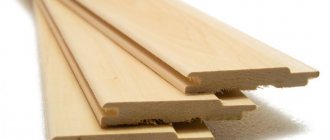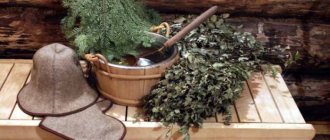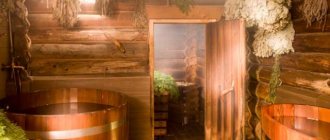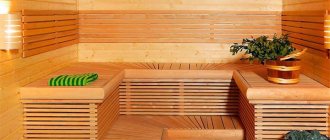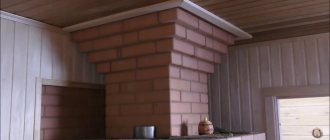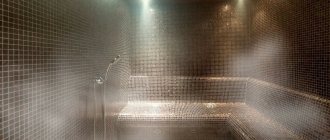Aspen, linden or alder - which lining is better for a bathhouse?
Construction of an exclusive bathhouse is a very interesting and promising process. How great it is to steam in your own sauna, enjoying communication with friends and family. And what can set you in the right mood better than a room decorated with natural materials? At the same time, it is not necessary to invest fabulous funds to create a virtuoso masterpiece. You can use a little trick and cover the walls and ceiling with regular wood paneling.
Having chosen clapboard to decorate your own bathhouse, before going to the store for materials, you need to choose the right type of wood. And in order not to make a mistake when buying aspen linden or alder lining for a bathhouse, we suggest that you familiarize yourself with the features of each of them.
What should you consider?
The main factors that you should pay attention to when choosing wooden lining are the class of material, the country of manufacture and the type of wood. At the same time, they try to consider raw materials from deciduous trees specifically for baths, since coniferous types, as a rule, are oversaturated with specific resins. Under the influence of high temperatures and moisture that reign in the sauna, the resins begin to melt, appearing on the walls as viscous drops. Essential oils of conifers, although they have healing properties, can still pose a threat to human health in too concentrated form. Hardwood, on the other hand, does not highlight anything, which means it is ideal for interior decoration.
Article on the topic: What is cheaper than a fence made of wood or corrugated board?
It remains to be decided whether there is a difference between the lining for a bathhouse made of aspen, linden or alder, and whether it is worth paying more. Let's take a closer look at each type.
Advantages of linden lining
It is impossible not to fall in love with this tree at first sight. A rich color palette from almost white with a barely noticeable pink tint to rich golden brown. Moreover, the shade can change during use, surprising the owners with the novelty of the color.
The great advantage of linden is the pliability of the material for tools. The boards do not crack or deform during operation, and take any necessary shape. Thanks to treatment with special protective agents, linden lining will last for many years without losing its attractiveness and strength.
Linden slats are ideal for finishing rooms inside a bathhouse, since the material can withstand sudden temperature fluctuations and is not afraid of high humidity (up to 100%). The surface of the boards is slightly dirty, and it is not difficult to wash off stains.
It is worth noting that linden lining has a healing characteristic aroma and heats up slightly when exposed to high temperatures. Being in a linden bathhouse is not only emotionally comfortable, but also beneficial for health.
Choosing wood for cladding
If you make a list of the most popular types of wood for a bathhouse, you will get something like the following:
- Birch lining is the worst suited for a steam room or sauna; the tree is desperately afraid of hot steam and is highly susceptible to rotting;
- Pine and Christmas tree;
- Oak, cedar or ash are very beautiful in the decoration of bathhouse recreation rooms. Both have excellent textures and good staying power;
- Linden and alder are the best lining options for a bathhouse.
Pine, Christmas tree, birch for a bath
If anyone wants to cover a bathhouse with birch, you should be aware of the poor resistance of its wood to moisture. You will have to try hard to increase the ventilation of the bathhouse and use preservatives to preserve the wood from decomposition. The huge pores of birch fibers cannot be protected even with the help of varnishes or deep penetration impregnations.
Coniferous lining is much more resistant; due to the high concentration of tar-like substances, resins, and oleoresins characteristic of coniferous wood, their use as bath lining is limited. Even thermal and chemical surface treatment to remove resinous substances gives only a temporary effect. Moreover, in hot steam, pine or spruce can change the tone or even color of the surface. The ability of coniferous lining to accept color well and to be freed from surface layers of gum resins and turpentines is often used by various kinds of schemers. After treating with an alcohol-acetone mixture, the sauna lining can be easily painted and even painted to look like ash or alder. True, after 2-3 weeks of exposure to dry, hot air, such lining will quickly lose color and acquire a gray tint.
Sometimes pine or spruce lining is simply steamed several times with dry steam; resins and resin are expelled from the surface of the wood, which is simply removed by mechanical scraping and grinding. For quite a long time, this process frees the steam room of the bathhouse from the smell of tar and tar, but after a couple of months it will definitely appear again.
Oak, cedar, ash, aspen for steam room
Oak lining is very durable and resistant to any influence of water and steam; in a bathhouse, such lining will last in a steam room for many years, but oak does not have any outstanding decorative properties, in addition, such lining has a high price and is difficult to work with.
Cedar and ash lining is perfect for both the steam room and the entire bathhouse. Cedar and ash have a beautiful pattern; in ash, this is especially evident when the surface is dry, varnish-free polished. The price of such lining is comparable to the price of expensive finishing types of wood, therefore it is used to a limited extent for cladding saunas and baths.
Aspen can hardly be called a high-quality material for cladding. Even when used correctly, aspen lining is often darker, but does not rot like birch. If you decide to consult with sellers of ready-made material for cladding a bathhouse, be prepared to listen to many different tales about the miraculous properties of aspen and aspen stakes.
Alder, linden, larch
Lining made of linden and alder for a bathhouse is valued above all. In addition to their excellent durability and light or even white color, you can add an indescribable aroma that appears every time the wood is heated with hot air. They have soft and pliable wood, so such lining can be easily cut and sawed.
Separately, it is worth mentioning another type of wood - larch. A lining made from this wood will last as long as oak and alder combined. Larch has a high resin content, which provides good resistance to rotting, swelling or cracking when exposed to high temperatures. The disadvantages of larch include the specific dark red color of the wood, which, unlike white linden or light coffee alder, makes the enclosed steam room dark. The smell of heated larch also takes some getting used to; most people like the slightly tart aroma of larch.
Larch wood is heavier than that of light linden, it holds heat less well and, most importantly, its wood is unusually hard. One poorly screwed screw can cause the entire board to crack.
Advantages of aspen lining
Aspen wood practically does not crack during operation, all because it has very low thermal conductivity. Although during finishing installation, such lamellas easily take the desired shape and bend freely. Relatively lightweight boards are much easier to transport.
Rooms finished with aspen are always very light, since the wood itself has an attractive white color with relatively thin fibers. The almost complete absence of knots is another significant plus in the basket of this breed.
If we talk about the disadvantages of aspen slats, then we can note the tendency to rot in the case of low-quality raw materials (trees over 45 years old) or unscrupulous installation. But if the installation was carried out according to all the rules, then there is nothing to worry about.
Article on the topic: How to install a gas convector in a wooden house
If you compare the lining for a bathhouse aspen or linden, it is difficult to say for sure. Both materials are excellent for construction. Rather, it is necessary to focus on the material side of the issue. Definitely fake panels will cost more. This is why craftsmen often prefer aspen boards. The use of linden panels in the decoration of the sauna will serve as proof of the good taste of the owner.
Features of alder lining
Another frequently used material for finishing a bath is alder slats. A reasonable price and good quality indicators have allowed alder to firmly gain a foothold among the favorites of craftsmen of all generations.
The resistance of wood to high humidity and temperature fluctuations is affected by the difficult growing conditions of the tree, since black alder is mainly mined in harsh northern latitudes on swampy soils.
Its main feature can be considered increased hygroscopicity. Alder boards absorb moisture well. Reduced thermal conductivity does not allow the material to overheat, which protects a person from thermal burns, and good noise insulation will protect you from external fuss.
The tannins contained in wood help fight the proliferation of pathogens and also contribute to the health of the human body.
When comparing sauna linings made of alder or linden, one cannot fail to note the peculiarity of alder slats when heated to change color greatly. Moreover, the effect is cumulative and over time in a darkened alder room you will have to think about an additional light source. It is also necessary to take into account the specific cognac aroma of alder, which not everyone may like. However, the smell disappears quickly enough and if all other indicators are satisfactory, then the worries are in vain. A significant bonus for black alder is its price. The cost will pleasantly surprise you in comparison with linden boards.
You need to choose lining for a bath from aspen, linden or alder not only based on external qualities or price characteristics. A comprehensive consideration of all factors will help to calculate the best option for each bath, depending on the wishes and capabilities of its owner.
Article on the topic: How to make a canopy for a bathhouse
Which lining is better for a bathhouse?
When a person has prepared a special area for a bathhouse at his dacha, it is important now to think about finishing it from the inside. You can decorate the inside of a bathhouse in different ways; a variety of materials are used for this. It can be stone or the usual lining, which is made of wood.
Of course, lining is the ideal choice. This material is environmentally friendly and natural, therefore suitable for a bathhouse and its arrangement from the inside. Thanks to him, the room will have a beautiful view. To choose a type of lining, you need to learn about its types and characteristics.
Usually there are 2-3 rooms in a bathhouse. This is a dressing room, a steam room, and in some saunas there is also a room where you can wash. Each room has its own requirements regarding environmental friendliness and safety. The materials used for finishing should not only look beautiful, but also have excellent technical properties. However, the main requirements are resistance to high temperatures, moisture, and water.
Options for lining for a steam room
This type of cladding has become very popular. In this case, the material may differ in processing method, class, type. It is important to understand how to choose the right lining. And you also need to think about shelves, seats, and decorative elements.
For installation inside the steam room, panels made of hardwood are used. This material has a smooth, even surface that does not have any damage. In addition, when wood is exposed to high temperatures, beneficial substances are released that have a positive effect on human health.
Production Features
Linden round timber is used to form boards that are dried using chamber or natural methods. In the latter case, the workpieces are stacked and left for the period specified by the processing technology (often calculated in years). Artificial drying is carried out in special chambers where the lumber reaches the required degree of humidity. During drying, a concomitant selection of wood is carried out: those blanks on which no cracks have formed are sanded and equipped with a tongue-and-groove system.
Alder lining is made from the following species:
- black,
- white,
- Siberian
The material is sorted and logs are formed from thick trunks, which are processed with carpentry and turning tools. The illiquid part of the wood is sent for chips and firewood. The homogeneous structure of alder makes it easy to mold into different types of cladding.
Choosing a lining for a waiting room
A dressing room is a room in which people relax. There are no high temperatures here, so any type of wood can be used to finish it. If you cover the walls with panels made of coniferous trees, then there will always be a pleasant aroma inside the room. They also often buy birch, linden, and aspen for this purpose; they are popular when it comes to finishing a bathhouse.
Article on the topic: How to get rid of the smell of drying oil in a bath
It is recommended to use identical material for cladding walls and ceilings. Do not cover products with paints or varnish. To extend the service life of the lining, there are different impregnation options.
What functions should the finishing perform?
When choosing interior decoration for a bathhouse, you need to take into account several important points. The first question is whether additional finishing is needed in principle. If the bathhouse is built from large diameter logs, you can leave everything unchanged.
For buildings made of other materials, you will need clapboard or board. It will help create a special bath flavor inside the premises and provide high-quality insulation. Plus, the lining has different profiles and can be mounted vertically and horizontally, in the form of masonry or herringbone.
You can also use a block house or imitation log, and even an unedged board, which will give the interior of the bathhouse a special zest and unique natural flavor. To make the right choice, you need to familiarize yourself with the requirements for interior decoration in a bathhouse.
In addition to decorative ones, wall cladding has practical functions. It accumulates and retains heat, which allows you to spend a minimum amount of energy resources.
At the same time, the surface of the skin remains pleasant to the touch and does not burn.
To effectively perform its functions, the cladding material must have the following characteristics:
Be non-flammable. To give this quality to natural wood, it is treated with special compounds.
Absorb and retain heat without getting hot.
Have high moisture resistance and dry quickly.
Have a natural and environmentally friendly composition, do not emit harmful substances and unpleasant odors.
Choosing a lining for a steam room
Here the ceiling and walls are finished with high-quality lining. It is able to withstand high levels of humidity and temperature, the influence of steam and water. To successfully cover the inside of a bathhouse, you should take time to take care of the quality of the material used.
If you know about the types of wood and its properties, then it will not be difficult for you to choose the best option for the steam compartment. Hardwood is best. In the case of coniferous varieties, harmful resins will be released as a result of high indoor temperatures.
The material is known for its advantages - wear resistance, durability. Since it is resistant to water, cracks will not appear on the surface of the lining when the wood dries. This way you can avoid deformation.
Linden panels have a high level of thermal conductivity. Thanks to this lining, the heat will be distributed evenly inside the steam room, and the time during which the walls will cool will be reduced. Since such panels have a low heat capacity, a person will not get burned if he suddenly touches the surface.
Aspen
There are also many advantages here. This material will not deteriorate during drying.
Since customers often buy aspen paneling, this has made it possible to create a large assortment of ready-made panels that differ in size and shape. Many people ask what type of wood would be best for finishing a steam room, but this is all individual. Before buying a product, it is important to check it for small knots, chips, and damage. If the material is of high quality, then the finished coating will be attractive and durable.
Which material is preferable for lining a bath?
To equip the room reserved for the steam room, you should use lining made of coniferous and hardwood. In order to make the right choice, you should first familiarize yourself with the main characteristics of each type.
Abashi
Abashi-based lining is often found in bathhouses. The tropical representative has established itself as a practical material from which shelves are made that are practically not subject to heating. The tree comes from Africa, has a chocolate hue and a low density. Abashi darkens only after undergoing heat treatment, and before that the canvas has a white (sugar) or lemon-yellow color. There are no sharp tonal transitions, knots, pockets or other irregularities. As a decorative approach, sheets of untreated wood are alternated with treated ones, which allows you to create an original composition.
Hemlock
Also called Canadian hemlock. A representative of an evergreen plant that is often used in modern construction. It reaches maturity at 300 years of age, at which time it reaches a height of 50 m. It is similar in appearance to oak, for which it received its second name as American oak. The advantages of the material include a pleasant and light aroma of pine needles, a long service life, and increased strength and endurance.
Larch
This finishing material is distinguished not only by the original properties of the wood itself, such as high strength, elasticity, and specific gravity, but also by its excellent external characteristics. The sections reveal the unusual structure of the rock, which allows you to achieve an unusual effect and an interesting composition in the interior. Such material will never be cold, so it can please its owners for several years. The relevance of the use of the material is due to the presence of antioxidants in the structure of the material, which help cope with external factors. The cost of the cladding is high, which is not justified.
Cedar
This type of finishing material speaks of the high and refined taste of the owner of a bathhouse or sauna. Cedar lining will give the interior a unique style. The North American representative is the easiest to identify, as it has a reddish tint and an unusual aroma, which is considered medicinal for diseases associated with the heart and respiratory tract. The material is valued for its unusual structure, deep pinkish tone and unsurpassed aroma, which creates the necessary atmosphere in the room. It is characterized as a stable, durable material capable of disinfecting the air.
Alder
Alder lining, which is used in the manufacture of structures of high European quality, is also valuable. The black variety of alder, which is called royal wood due to its deep pink tone, is in demand. Practically does not require further processing, since knots are rare. The structure of the rock is resistant to various deformations, smooth, uniform. The material is not afraid of steam and moisture, which makes alder lining an indispensable assistant when arranging such premises as steam rooms in saunas and baths. There are different shades.
Aspen
The homogeneous and at the same time dense structure is considered a quality characteristic and is similar to linden. Aspen lining has a slight bitter aroma, which is due to the increased hardness of the material, which indicates a high service life of the product.
Before purchasing, you should pay attention to the absence of knots on the surface and the presence of resins, which is unacceptable, as it leads to difficulty breathing. Aspen lining is characterized as a high-quality material that undergoes careful sorting and selection
Linden
Linden lining is used as a finishing material for walls and floors. For a bathhouse, this type of material is considered the best way to decorate the premises. The structure of linden allows the surface to heat up quickly, the structure is soft, skin burns can be avoided due to its low thermal conductivity. Due to thermal conductivity, the material will slowly cool, which plays an important role in the case of baths or saunas. During the heating process, the material releases honey vapors, which emit a pleasant aroma. The essential oils contained have a beneficial effect on the body as a whole. The wood has excellent external characteristics and does not require additional processing.
Alder
The lining, which is made of alder, is preferred by authoritarian lovers of relaxation in the bathhouse. The material will cost more than the previous ones, but it is considered to be of higher quality. Here the surface is perfectly smooth and there are no defects. Therefore, after installation there is no need for additional processing using a grinding machine.
Article on the topic: Why the Astrakhan baths were closed
This wood is used for steam rooms, which are located in elite, expensive establishments. It is popular because it has healing properties and looks very beautiful. Cedar panels are made, processed and installed quite simply; no special approach is required.
Behavior of alder in a humid environment
During bath procedures, alder practically does not absorb moisture, so it does not lose its properties and does not become deformed. It has low thermal conductivity, the lining and shelves do not heat up and do not burn.
This wood can “breathe”. Moisture and condensation do not accumulate on the walls, so the alder does not rot.
Alder is a natural antiseptic; it does not need to be treated with additional antibacterial compounds. The healing properties of the tree have a beneficial effect on health.
Rare breeds
When it comes to “Extra” class lining, it is expensive, because its quality is at a very high level. Compared to others, these materials look beautiful, are durable and have superior technical characteristics.
In terms of sophistication, oak is the best. Panels made from this type of wood are heavy and have an incredibly beautiful texture. In addition, oak structures have always been famous for their durability.
Abash (African wood) is also often used to decorate baths. It will not heat up, even in very high temperatures. And this is its unique property. Therefore, this breed is very often used to make shelves for the steam compartment. They also line the ceiling and walls.
Grade and profile
Eurolining and domestic material undergo the same stages of processing and drying. Separation into classes occurs immediately before packaging. There are three main categories: A, B and C. Recently, manufacturers often also distinguish the “Extra” or “Premium” class. The lining for saunas and baths must correspond to grade “A”, however, the use of extra-class timber can increase the service life of the cladding.
The board that is taken to finish the bath can be one and a half, three or six meters long. The size should be selected based on the dimensions of the room and the smallest number of joints between finishing parts. Only eurolining is suitable for use in a steam room, the fastenings of which are made using the “tongue/groove” technology. Thanks to this system of joints, the thickness of the cracks in them is minimized.
Advantages of eurolining
Unlike domestic analogues, it is produced not according to regional GOSTs, but according to international standards. It is the eurolining that has the “Extra” and “Premium” class. It is noted that it is subjected to more thorough surface treatment and a high level of drying. Equipped with longitudinal grooves for ventilation and stress relief from the wooden beam. Sheathing elements remove excess condensation. Eurolining has an improved fastening system. This is facilitated by deeper mechanisms. The characteristics of foreign class “A” boards are much higher than the GOST parameters, and, according to domestic requirements, it can be classified as “Extra” grade.
The advantages of Euro timber affect the final cost, so the demand for it is not too great. The dimensions of foreign and local material are practically no different: thickness - 12.5; 14 and 15 mm, and the width can vary from 80 to 135 mm excluding grooves. Eurolining has more stringent parameters, and in domestic products some errors are allowed. Although this, if it affects the final result of the facing work, is insignificant. You need to decide and choose between an imported and a domestic manufacturer based on the estimated cost of the bathhouse. Imported and domestic materials in the mid-price category are almost the same in the quality of wood and its processing.
Choosing a shower lining
Usually all rooms in the bathhouse are finished with wood. This also applies to the shower. Water constantly flows here and there is high humidity, so panels made of coniferous wood are in demand here.
To ensure that the floor covering lasts longer, does not rot and has better properties, you can apply a water-repellent agent. The surface, which has been previously cleaned and sanded, is coated with water-based paint or protective wax. In some cases, several layers are applied to achieve a better effect.
Article on the topic: How to sew a bath hat
But all these procedures should be carried out by professionals who know the intricacies of installing wood panels, wall cladding and bathhouse ceilings.
You can order finishing of baths and saunas on our website or by calling.
Finishing the bathhouse with alder
Alder belongs to the birch family. This is a large tree, the height of which can reach 25 m. The most popular types are black alder (bark with cracks) and gray alder (smooth bark). The wood is of medium density with faintly defined annual rings.
Advantages and features of alder:
- due to its softness, alder is easy to process;
- wood almost does not shrink, does not deform or warp even after several decades;
- due to the porosity of alder, moisture evaporates from it quite quickly, which is a definite advantage when used in a steam room;
- This tree has gorgeous shades ranging from reddish-white to light red-brown. To emphasize the texture and color, it is recommended to cover alder with wax;
- the price of alder paneling is low, which for some is a compelling argument.
Disadvantages of using alder in a bathhouse:
- over the years, alder loses its original appearance due to its tendency to darken;
- At low temperatures, moisture accumulates in the pores, which can cause wood to rot. Therefore, if you use alder to build a log house, it must sometimes be treated on the outside with special compounds;
- a bathhouse made of alder requires additional insulation.
Using linden in the bath
Linden belongs to the genus of deciduous trees; there are more than 50 species. A distinctive feature of the material is its uniform structure and shine. Dry density is 495 kg/m3. The tree rings are barely visible on the saw cut, the structure is poorly defined, and sometimes there are knots.
Article on the topic: Infrared sauna - how to steam properly
Pros of linden wood:
- the wood is soft, so it is very easy to work with;
- due to its physical properties, linden is not prone to cracking and drying out;
- a steam room made of this type of wood heats up quickly and retains heat for a long time;
- linden has beautiful light shades, the color does not change over time;
- if you decide to build a bathhouse from linden, then such a structure will not require a massive foundation.
Using linden in a bathhouse - disadvantages:
- In the advantages we indicated the softness of the wood, but this is also its disadvantage. For processing this is a definite plus, but for durability it is a minus. However, with proper care, the bathhouse will last for many years;
- linden is susceptible to rotting and fungal attack, so the material must be regularly treated with products;
- the cost of linden and lumber from it cannot be called low.
As you can see, both alder and linden have their drawbacks. Weigh all the pros and cons to understand which advantages of a particular type of wood are closer to you!
What to expect from linden and alder?
After 3-5 years of operation, there is a high probability of darkening of the linden lining; to avoid discoloration and destruction of the wood, it is important to ensure high-quality ventilation. Sanding will help restore the natural color of the lining: you need to remove a layer within 14 mm. The lining can be protected with liquid agents that preserve the aesthetics of the lumber; they prevent the development of fungi and the absorption of dirt, although they reduce the intensity of medicinal fumes, the pleasant smell is less emitted.
It is customary to impregnate alder with protective compounds and antiseptics; its color is adjusted using paint and varnish solutions.
